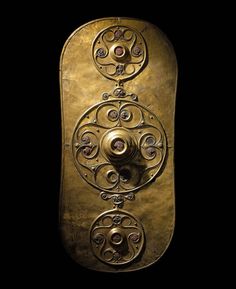A unique bark shield, thought to have been constructed with wooden laths during the Iron Age, has provided new insight into the construction and design of prehistoric weaponry, researchers say.
The only one of its kind ever discovered in Europe, the shield was found south of Leicester, UK on the Everards Meadows site, in what is believed to have been a livestock watering hole.
Following analysis of the construction of the shield by researchers at the University of York in the UK, it became apparent that the shield had been carefully constructed with wooden laths to stiffen the structure, a wooden edging rim, and a woven boss to protect the wooden handle.
Although prior evidence has shown that prehistoric people used bark to make bowls and boxes, this is the first time researchers have seen the material used for a weapon of war.
The outside of the shield has been painted and scored in red chequer board decoration.
Radiocarbon dating has revealed that the shield was made between 395 and 255 BC.
The shield was severely damaged before being deposited in the ground, with some of the damage likely to have been caused by the pointed tips of spears.
Further analysis is planned to help understand if this occurred in battle or as an act of ritual destruction, researchers said.
"This truly astonishing and unparalleled artefact has given us an insight into prehistoric technology that we could never have guessed at," said Michael Bamforth, from the University of York.
"Although we know that bark has many uses, including making boxes and containers it doesn't survive well in the archaeological record," Bamforth said.
"It was only through experimentation that we realised it could be tough enough to protect against blows from metal weapons.
"Although a bark shield is not as strong as one made from wood or metal, it would be much lighter allowing the user much more freedom of movement," he said.
The shield was first discovered by archaeologists in 2015 at an Iron Age site within a farming landscape known to have been used and managed by Iron Age communities.
Many cutting-edge analytical techniques have been used to understand the construction of the object, including CT scanning and 3D printing.
Latest World News
